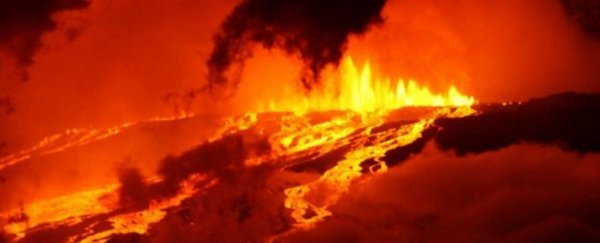Not all volcanoes are suddenly explosive. Some spew steady rivers of gloppy, slow-moving lava for millennia on end, like those in the Hawaiian or Galápagos islands.
These are what volcanologist Michael Stock from Trinity College Dublin in Ireland calls the 'boring' volcanoes – yet underneath their monotonous exterior, lurks a bombshell that Stock and his colleagues have just discovered.
Analysing microscopic crystals in the basalt and ejected material of two volcanoes in the Galápagos, the researchers found hidden systems of magma that are not so simple or predictable after all.
Even though the Wolf and Fernandina volcanoes in the Galápagos have seemingly spewed the same basaltic lava for their entire existence, the new findings suggest they are sitting on a chemically diverse system of molten rocks, some of which have the potential to set into motion explosive activity.
Just because these volcanoes appear boring on the surface doesn't mean the monotony will continue forever, the researchers say.
"This was really unexpected. We started the study wanting to know why these volcanoes were so boring and what process caused the erupted lava compositions to remain constant over long timescales," says Stock.
"Instead we found that they aren't boring at all - they just hide these secret magmas under the ground."
There's no reason to think these two Galápagos volcanoes are about to change their eruptive behaviour any time soon. These sorts of things happen at a pace even a snail would tap its foot at.
Still, the study does indicate a way in which seemingly innocuous volcanoes could potentially become eruptive in the far future, and goes some way to explaining how they could have done so in the distant past.
"This discovery is a game-changer because it allows us to reconcile apparently divergent observations, such as the presence of explosive deposits at several Galápagos volcanoes," says Benjamin Bernard, a volcanologist involved in monitoring Galápagos volcanoes at Instituto Geofísico.
"It also allows us to better understand the behaviour of these volcanoes, which is essential for volcano monitoring and hazard assessment."
While the Wolf and Fernandina volcanoes are thought to spew mostly-uniform basaltic lava, which has relatively low viscosity, the new study found evidence for other evolved magma forms flowing below at various depths.
This diversity of magma, however, appears to be drowned out by large volumes of basaltic magma, ascending through the crust from a hot spot, or plume of hot magma, beneath Wolf and Fernandina.
"Hence," the authors conclude, "monotonous activity does not reflect simplicity or chemical homogeneity in magmatic systems."
Instead, it could say more about where the volcano is situated in regards to the hot spot. Large volumes of basalt rushing through the crust, the authors argue, would be enough to overwhelm other more explosive forms of magma, which tend to be rich in silica.
These plumes of basaltic magma, however, are not fixed, and while they can persist for tens of millions of years, they do move, albeit very slowly.
Knowing where they are going and how these tiny shifts can impact volcanic eruptions will help us better prepare for the future, however far down the road that may be.
Underneath Wolf and Fernandina, researchers found magma compositions similar to those that erupted at Mount St. Helens in 1980. At the surface, however, lava was 90 percent basalt.
"Magmas are more likely to erupt explosively when they have higher silica and water concentrations," Stock explained to Newsweek.
"The water forms gas bubbles – the same as carbon dioxide in cola – but the high silica content makes the magmas very sticky. The gas bubbles can't escape so pressure builds up, generating an explosive eruption."
For now, we'd do best not to judge volcanoes solely by their calm exteriors.
The study was published in Nature Communications.
